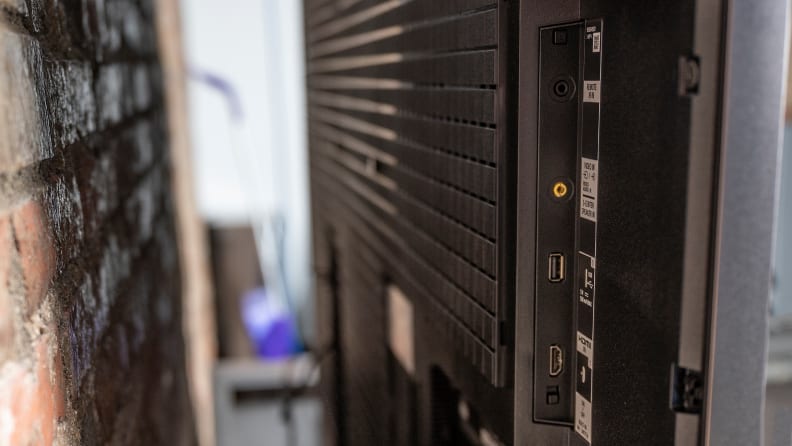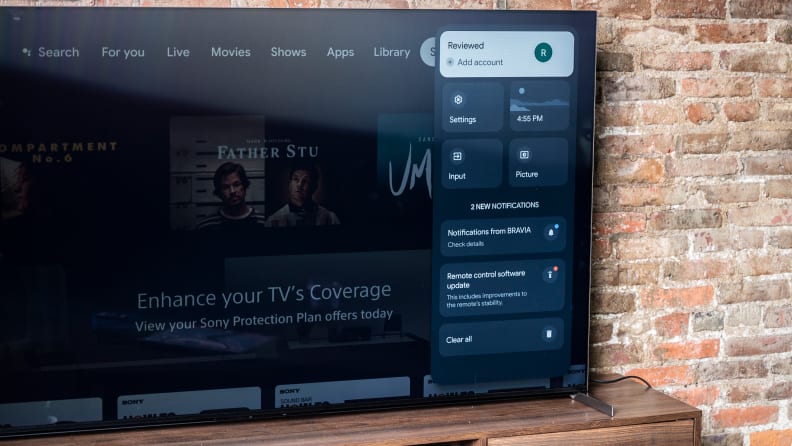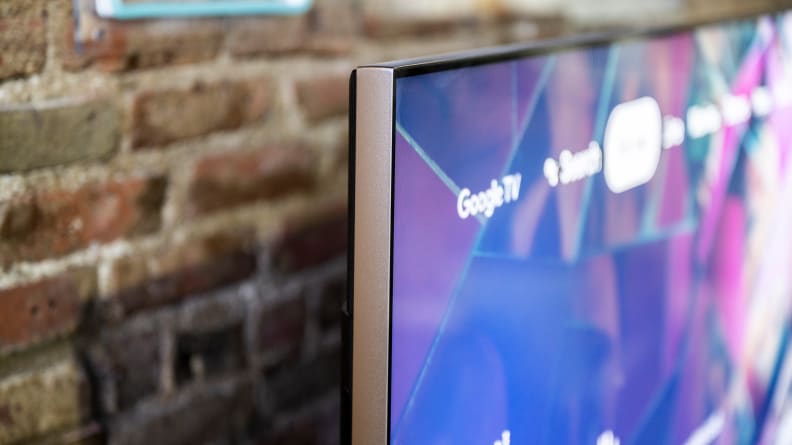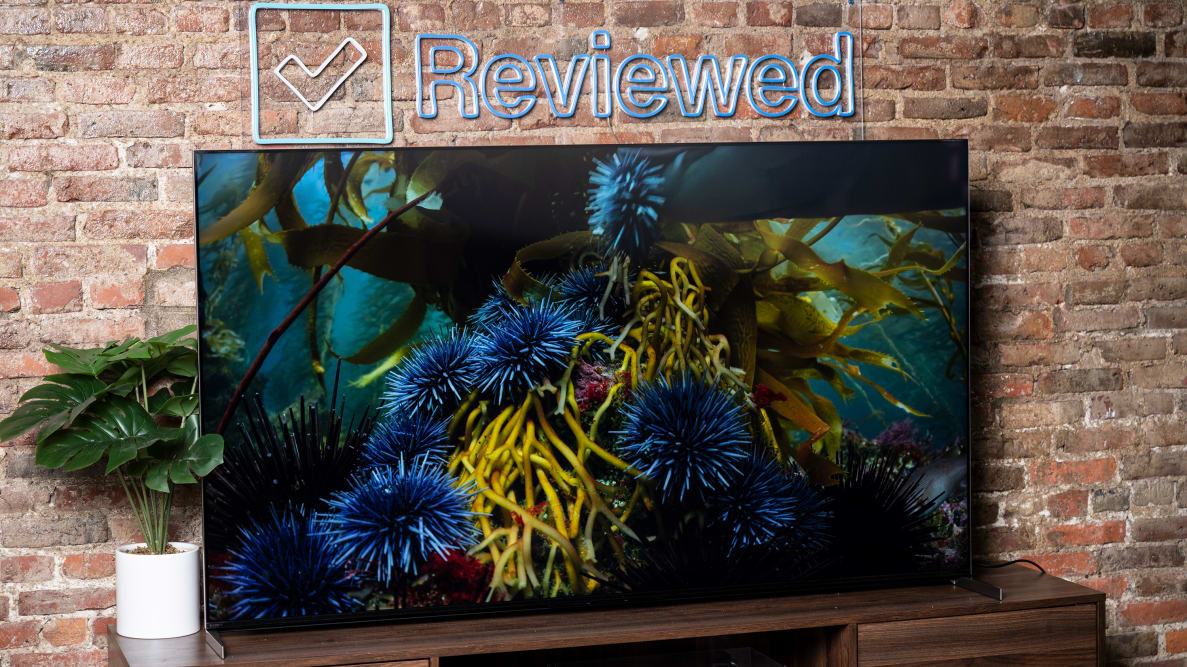Pros
-
Bright and colorful HDR
-
Sleek, adjustable design
-
Snappy software
Cons
-
Black levels suffer in bright scenes
-
Noticeable light bloom
-
Gaming support is lacking
That’s not to say that the X95K isn’t impressive. It’s stupendously bright regardless of what you’re watching, which makes it a fantastic bright-room option. It looks its best in HDR, however, where sizzling highlights and well-saturated colors can truly shine. The X95K’s adjustable stand design gives A/V enthusiasts plenty of flexibility, and as far as software goes, Google TV is one of the best smart platforms available today.
But the X95K is seriously pricey, and some of the TVs it’s going up against in that price bracket—the Samsung QN90B and the LG C2, just to name two—offer better overall performance and more next-gen gaming functionality. Because of this, the X95K doesn’t have as much of the spotlight as it ought to this year.
About the Sony X95K

The new standard Sony remote comes with a built-in microphone.
The Sony X95K is available in just three sizes, the smallest of which is a hefty 65 inches. Our review unit is a 65-inch model on loan from Sony.
Here’s how the series shakes out in terms of pricing:
- 65-inch (Sony XR-65X95K), MSRP $2,799.99
- 75-inch (Sony XR-75X95K), MSRP $3,799.99
- 85-inch (Sony XR-85X95K), MSRP $5,499.99
While we don’t expect there to be major differences in performance between these sizes, it’s worth noting that, typically, each size variant of a mini-LED TV series features a different amount of dimming zones. The number of zones tends to increase proportionally to a TV’s size. A difference in zone count could spell slight differences in how a TV performs.
With sizing and pricing out of the way, let’s take a look at the TV’s specs:
- Resolution: 4K (3,840 x 2,160)
- Display type: Full-array mini-LED with quantum dots (VA-style panel)
- HDR support: Dolby Vision, HDR10, HLG
- Dolby Atmos: Yes (native decoding and passthrough via eARC)
- eARC support: Yes (HDMI 3)
- Native refresh rate: 120Hz
- Smart platform: Google TV
- Color: DCI-P3 color space/10-bit chroma resolution
- Variable Refresh Rate (VRR): Yes
- Auto Low Latency Mode (ALLM): Yes
- Processor: Cognitive Processor XR
- Other features: Bravia Cam, IMAX Enhanced mode, Apple AirPlay, Apple HomeKit, Amazon Alexa, Google Assistant, Google Chromecast
The X95K ships with a new version of Sony’s standard remote control, which offers a built-in microphone for voice controls and a handful of dedicated app buttons.
Connectivity

Only two of the four HDMI ports are the HDMI 2.1 specification, supporting 4K at 120Hz.
The Sony X95K is sporting enough connectivity options to satisfy most people, but dedicated gamers and A/V enthusiasts should take note of the TV’s HDMI specifications. Only two of the TV’s four HDMI ports support VRR, ALLM, and a 4K signal at 120Hz. Of those two HDMI 2.1 ports, one also functions as the TV’s eARC port. So if you have both a PlayStation 5 and an Xbox Series X, as well as a soundbar or AVR, you’ll have to give up 4K/120Hz gaming on one console or forgo eARC.
Here’s what you’ll find in an L-shaped cutout on the back of the X95K’s panel:
- 2x HDMI 2.0
- 2x HDMI 2.1 (4K @ 120Hz, 1x HDMI ARC/eARC)
- 2x USB (1x USB 2.0, 1x USB 3.0)
- RF connection (cable/antenna)
- Ethernet (LAN) input
- Digital audio output (optical)
- RS-232C
Performance data

The Sony X95K menus and Google TV OS are smooth with a peppy response.
Before testing each TV, we make sure the panel is on and receiving a continuous signal for at least 2 hours. Our 65-inch X95K received this standard warm-up time before any readings were taken. In addition, the TV received the latest firmware updates at the time of testing. After research and consultation with other experts we’ve updated our warm-up time from 24 hours to 2 hours which should be ample time for modern display technologies and also better approximates how real buyers use their TVs at home.
For both SDR and HDR tests, we’re using the X95K’s Custom picture mode. We’ve chosen this setting because of its accuracy, but performance may vary depending on which picture mode is enabled. For example, you might experience a brighter picture with different settings enabled, but it may interfere with color temperature and overall color accuracy.
For additional context, we also conducted both SDR and HDR tests in the TV’s Cinema picture mode, but these test results are not reported below.
To get a sense for the TV’s average performance, we use a standard ANSI checkerboard pattern for most of our basic contrast tests. We also use white and black windows ranging from 2% to 90% to test how well the contrast holds up while displaying varying degrees of brightness.
Our peak brightness measurements are taken with sustained windows to represent the TV’s peak brightness over a sustained period of time. Specular highlights (like brief flashes of reflected light) might reach higher brightness levels, but not for sustained periods of time.
All of our tests are created with a Murideo Seven 8K signal generator and tabulated via Portrait Displays’ Calman Ultimate color calibration software.
I'll expand on our test results throughout the review, but for now, here are some key takeaways:
• HDR contrast (brightness/black level): 723.1 nits/0.218 nits (ANSI checkerboard) • SDR contrast (brightness/black level): 545.8 nits/0.153 nits (ANSI checkerboard) • HDR peak brightness (sustained): 968.4 nits (40% white window) • HDR color gamut coverage (DCI-P3/10-bit): 91% • SDR color gamut coverage (Rec.709): 100%
During testing, the X95K’s Color Temperature was set to Expert 1. For SDR tests, the TV’s Brightness and Gamma sliders were kept at their default position: 35 and -2, respectively. For HDR tests, the tone mapping setting was set to Gradation Preferred.
The Advanced Contrast Enhancer, Black Adjust, and Live Color settings were all disabled, while both Auto Local Dimming and Peak Brightness were set to High. For Clarity-related settings, Sharpness was kept at its default position (50), Random Noise Reduction and Digital Noise Reduction were kept off, and Smooth Gradation was kept at Low.
What we like
Bright and colorful performance

The X95K delivers a truly excellent, punchy image to combat bright viewing environments.
Similar to Samsung’s Neo QLED TV lineup, the X95K blends mini-LEDs with quantum dots (though Sony refers to its quantum-dot technology as Triluminos color). These microscopic nanocrystals boost brightness and color fidelity, and from what we’ve seen, it’s nice to have them working in tandem with mini-LED backlights.
Like the QN90B (and most of the mini-LEDs we’ve seen to date), the X95K offers plenty of brightness and beautiful color in both Standard Dynamic Range (SDR) and High Dynamic Range (HDR). Regardless of what you’re watching or the time of day, the picture will be punchy and full of life.
This is because the X95K doesn’t just drive a ton of brightness to scene-specific specular highlights, but the entire picture, too. If you watch a good amount of TV during the day, the X95K is better equipped than most to stand up to the sunlight; its full-field brightness in SDR is slightly higher than the Samsung QN90B, according to our test results.
During HDR content, you can expect an even brighter overall picture—though this is where the X95K isn’t quite as good as the QN90B. While its fierce Samsung competitor is better equipped to pour an intense amount of luminance into small, punctuated pools of light, the X95K’s no slouch in this department; I measured specular highlights in the 950- to 1,100-nit range. (For comparison, the QN90B is capable of doubling this figure while displaying HDR highlights.)
The ability to allocate this much brightness for small highlights—together with Sony’s impressive image processing software—makes for a picture with a ton of depth, especially anything mastered for 4K HDR.
Its overall color production is a touch disappointing, but nevertheless great in nearly all use cases. Thanks in part to Sony’s Triluminos color technology, the X95K is able to cover about 91% of the extra-wide HDR color space (DCI-P3)—roughly on par with the Samsung QN90B, but lower than what I expected based on the TV’s hardware and brightness capabilities.
That said, it’s hard to be disappointed in the data from our lab tests when you actually watch HDR content on the X95K. Colors on this TV look well saturated and true to life, with very few adjustments needing to be made to the out-of-box Custom picture mode. Our X95K's color temperature was slightly cool out-of-the-box in both its Custom and Cinema picture modes, even after changing its Color Temperature setting from Expert 1 to Warm. Most people probably won’t notice (and all panels are different), but I suggest an in-depth calibration for the most accurate presentation.
Stylish, convenient design
From a design standpoint, the X95K is one of the best-looking TVs I’ve seen all year. Its bezels are razor-thin, the panel—while hefty—is nevertheless relatively slim given its complex internals. The back of the TV is wrapped in a sturdy, textured plastic that features a pleasing crosshatch pattern.
The X95K’s stand contains my favorite design feature: two diamond-shaped feet that can be positioned in three ways, depending on your living room layout or preference. I went with the narrow position (which keeps the panel as close to the tabletop as possible), but the alternative soundbar positioning ensures that there’s ample room for a soundbar beneath the picture.
All three of the stand positions look great, and the TV’s anti-reflection coating gives the X95K’s picture an elegant, matte-like finish.
Snappy software with plenty of flexibility
The Sony X95K comes with the Google TV smart platform baked in. After setting it up with an internet connection, signing in with a Google account, and potentially installing a software update, you’ll be good to explore pre-installed apps or install some new ones as needed.
The Google TV experience is similar to the old Android TV experience of years past: a dedicated home screen can take you from one app to the next, with a heaping helping of sponsored content to navigate around.
Despite the sponsored content (which is present on every smart platform to some degree), the best thing I can say about Google TV is that it’s fast. Having just reviewed a handful of Samsung TVs with slower-than-average software, it’s a breath of fresh air to jump from an input to an app and back without any menu hangups.
The Android software that makes up the bones of the X95K’s menu software is quite refined; it offers a bevy of audio and visual settings for those who like to tinker, and I appreciate how easy it is to access various picture settings through a quick menu that appears at the bottom of the screen.
What we don’t like
Lifted black levels are always looming

Unfortunately, the X95K displays more light bloom than its similarly-priced competitors, especially off axis.
My heftiest criticism of the X95K has to do with its struggle to rein in brightness during average scenes. I should note that, when I say “average,” I’m referring to sequences in which there’s roughly an equal amount of bright and dark picture elements on the screen (think: two people chatting in a bowling alley, or someone shopping at a grocery store).
During moments like these, the TV is doing such a tremendous job keeping the entire picture bright that its black levels are lifted in the process. Suddenly, the areas of shadow in the bowling alley background become a gray murk.
This can be observed while the X95K is displaying a black-and-white checkerboard pattern. With an equal amount of peak bright and absolute dark content on the screen at the same time, I never measured a black level on the X95K lower than 0.153 nits. For comparison, the Samsung QN90B produces a black level of around 0.025 nits with the same pattern on the screen.
The X95K’s black levels are much inkier when there’s more overall darkness on screen, presumably because the TV is relying on fewer mini-LEDs. However, these are the moments where light bloom is at its worst.
Light bloom can distract from the scene
The greatest advantage that the Samsung QN90B has over the X95K is its ability to minimize light bloom. In fact, having seen the X95K in action, I have a better appreciation for the QN90B’s local dimming. I’d still qualify it as a weakness for the QN90B, but the X95K’s severe blooming (particularly during off-axis viewing) illustrates that Samsung is still leading the pack when it comes to mini-LED local dimming.
There are two situations where the X95K really struggles to limit this phenomenon: whenever bright picture elements clash with darkness, and whenever the TV is being viewed from an off-axis position. When both of these circumstances are met simultaneously, the X95K looks its worst.
I watched bluish clouds of light hover around a character in Sense 8 who woke up on the floor of a dark church. Subtitles, candles, and other sources of light at the tops and bottoms of a frame spill over into the content’s letterboxes. All of these instances of light bloom intensified from wider viewing positions. Heck, even playback control menus lit up the picture.
This sort of behavior comes with the territory; there’s really no way around at least some light bloom, given the display technology. But I’ve had the benefit now of seeing many mini-LED TVs, and I can comfortably say that the X95K is not nearly as adept at limiting light bloom as last year's Samsung QN90A or the newer QN90B. Sony's model is better at limiting bloom than last year’s Hisense U8G, but given the X95K’s price, it really should be handling these tricky scenes better than it is.
The TV’s tendency to lift its black levels during scenes of average brightness combined with its light bloom makes me feel like a better overall experience is just beyond my grasp. An OLED TV like the LG C2 would eliminate light bloom entirely, while a TV like the QN90B seems to be a better-executed formula on how to maximize the efficiency of mini-LEDs.
The real kicker? As of right now, the X95K is pricier than both of those two alternatives.
Next-gen gaming support should be stronger at this price
Here’s some good news for casual and hardcore gamers alike: The Sony X95K comes with HDMI 2.1 inputs that support 4K gaming at 120Hz, and both Auto Low Latency (ALLM) and Variable Refresh Rate (VRR) are available right out of the box.
Unfortunately, here’s some bad news: Only two of the X95K’s HDMI ports support these features, and one of them also functions as the TV’s dedicated eARC port. This means that, if you own (or plan on owning) an Xbox Series X, a PlayStation 5 and an eARC-enabled soundbar or home theater receiver, one of your next-gen consoles will have to occupy one of the performance-limiting HDMI 2.0 ports.
In addition, the X95K’s local dimming functionality is currently limited when VRR is enabled, so gamers will have to choose between the benefits of local dimming and the smoother gameplay that accompanies VRR.
I’d be less inclined to focus on this particular pain point were it not for the X95K’s price, which again puts it right above TVs like the QN90B and the C2. Both of these competitors feature full next-gen gaming support across all four of their HDMI ports.
Should you buy it?
Maybe—but explore other options in this price range first

There might be more affordable options out there.
There’s a lot to love about one of Sony’s first attempts at a mini-LED TV. The X95K offers a bright, colorful picture that won’t wither under sunny, daytime conditions, and its ability to push for searing highlights will make HDR10 and Dolby Vision content really sing. I can’t get enough of its sleek design, and I appreciate how easy it is to use Google TV.
But its flaws (a tendency to lift black levels, an unfortunate amount of light bloom, and half-hearted support of next-gen gaming features) begin to look more dramatic when you compare the X95K to other 2022 TVs in its price bracket. The LG C2, which employs an OLED panel, doesn’t suffer from any light bloom at all, and the Samsung QN90B offers better contrast control, less light bloom, and gets much brighter than the X95K. Both competitors deliver more flexibility for gamers, too.
There are tradeoffs, of course; the X95K gets much brighter than the LG C2, particularly when it comes to basic SDR viewing. The QN90B is hampered by slow, frustrating software and doesn’t support Dolby Vision.
Sony’s first attempt at a mini-LED TV is mostly a success, but the X95K’s premium price puts its blemishes front and center and there’s plenty of room for improvement—especially given its competition.
The product experts at Reviewed have all your shopping needs covered. Follow Reviewed on Facebook, Twitter, Instagram, TikTok, or Flipboard for the latest deals, product reviews, and more.
Prices were accurate at the time this article was published but may change over time.
Meet the tester
Michael Desjardin graduated from Emerson College after having studied media production and screenwriting. He specializes in tech for Reviewed, but also loves film criticism, weird ambient music, cooking, and food in general.
Checking our work.
Our team is here to help you buy the best stuff and love what you own. Our writers, editors, and experts obsess over the products we cover to make sure you're confident and satisfied. Have a different opinion about something we recommend? Email us and we'll compare notes.
Shoot us an email



